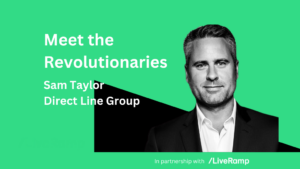New Digital Age (NDA) in association with LiveRamp, is spotlighting the men and women championing a data-led revolution in the marketing industry. ‘Meet the Revolutionaries’ focuses on the efforts of the industry executives helping to push digital marketing into a new era of data collaboration.
Here, we chat with Tim Abraham, Senior Director of Data Partnerships at The Trade Desk…
Tell me about your current role.
I’m currently working on our retail data partnerships for EMEA, having previously worked at Amazon and AOL. I’ve had various different roles across the ecosystem.
What does ‘retail data partnerships’ actually mean? We work with retailers like Ocado or Lidl to provide effective “offsite retail media” solutions for advertisers where media campaigns are running across the open internet. This is where retailers allow their data to be used by advertisers to target and measure those media campaigns and it’s a very innovative space.
Can you give an example of a time when you personally have helped to drive innovation?
Bringing retail data into the hands of CPGs is game changing. From The Trade Desk’s perspective, it’s also a positive move for the ecosystem as it supports an open internet away from walled gardens. The innovation is that, through retail data, CPGs have an alternative to walled gardens.
Ocado is the biggest online grocer and delivers to most of the country with around a million shopper households. In a privacy-safe way, they can make transaction data usable for targeting as well as campaign measurement, reporting and optimisation. The CPG company can tick a box to target users who have previously purchased certain products, find out for example whether ads work better on a Monday or a Thursday, and if CTV or DOOH is better. Being able to do that targeting and measurement in real time is a really big win.
What are the most common challenges to innovation?
Probably the biggest is giving people the time and space and organisational support to try and push the boundaries. Being able to fail is important.
At AOL, we had a problem where people had ideas but it was all just a bit wishy-washy. We set up a regular afternoon and a forum where people would come in and discuss in groups, building real action plans and engineers would be allocated to work on those.
The other blocker is ‘cathedral thinking’. Recognizing that innovation can take time and giving someone a week to work on something doesn’t mean that you’ll have amazing new things next month. You need to recognise that you have to create space in the organisation for it to happen.
What tips can you offer others hoping to drive innovation?
I have two pointers. One is to avoid groupthink. If you put ten people in a room with the same background and the most senior person in that room has a strong opinion, you’ll struggle to innovate. Diversity and inclusion, bringing people together with different backgrounds is key. You then don’t get an echo chamber with everyone just agreeing and no-one really challenging it.
From a practical perspective, having worked at Amazon they have a very practical approach. If you’re trying to innovate and you’re trying to get the stakeholder to buy into it, one of the first things you do is write the press release or internal memo or briefing form for that product. Put yourself in the mindset of ‘I’ve done this already’.
This forces you to be more precise about what it is you’re trying to do. As humans, we’re much better at understanding the output of a project rather than all the steps that go into the process. It’s really useful when talking to a senior stakeholder.
How do you think digital marketing might evolve over the next few years?
I think there are three main trends. One, being more data-driven. More data will be used to decide who to show ads to, when to show them and how often. Beyond that, metadata around things like bid offer spread in real-time bidding.
The second trend is that CTV will see huge growth. WARC is saying they expect 10% annualised growth over the next five years. Given the cost-of-living crisis, that is phenomenal growth.
The third aspect is trust. We believe there will be more scrutiny from consumers and advertisers and even publishers around the data being used. What media am I buying, how do I know where it’s coming from and how many different hops are there in the chain before it’s delivered to me?










